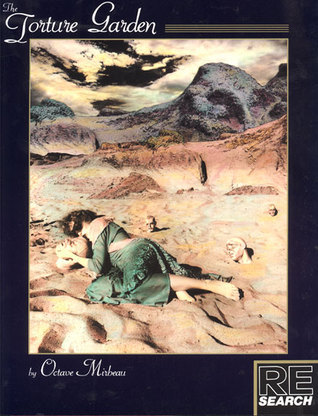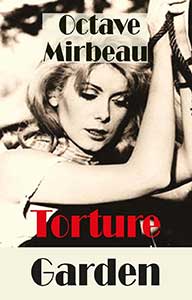 By OCTAVE MIRBEAU (RE/Search; 1899/1989)
By OCTAVE MIRBEAU (RE/Search; 1899/1989)
I can sum up the essence of THE TORTURE GARDEN (LE JARDIN DES SUPPLICES) in two words: Ecstatic Delirium. The quintessence of fin-de-siecle decadence, this transgressive masterpiece by the French anarchist Octave Mirbeau (1848-1917) has yet to be equaled, much less surpassed (although many of Mirbeau’s other novels, particularly THE DIARY OF A CHAMBERMAID and ABBE JULES, come close to doing so).
Following a dedication that sums up the author’s aims quite adequately (“To priests, soldiers, judges—to men who rear, lead or govern men I dedicate these pages of violence and blood”), the novel commences with a discussion amid several high profile men about murder, apparently “the very bedrock of our social institutions.” Eventually one of the participants, identified as “the man with the ravaged face,” hijacks the conversation to point out that women are nature’s ideal murderers. For confirmation the man relates an extended episode from his own life that takes up the remainder of the book.
The story related by the man with the ravaged face begins with political misadventure. He commenced his adulthood, he claims, as an esteemed political official but was disgraced, and attempted to save face by embarking on a bogus scientific expedition in the orient. This portion of the novel is admittedly a mite dull, albeit with a flicker of interest due primarily to the fact that, based on Mirbeau’s descriptions of late eighteenth century mores, very little seems to have changed from then to now (as a peripheral character states, “To take something from a person and keep it for oneself: that is robbery. To take something from a person and then turn it over to another in exchange: that is business”).
Reader interest is increased considerably when the narrator boards a steamer, upon which he becomes involved with Clara, a redheaded Englishwoman given to “strange lapses, flights of fancy, incomprehensible caprices and terrible desires.” She ensnares the man in a torrid affair that leads to a secluded area of China where, in a vast, surreal garden, torture is practiced as an art form.
In this hallucinatory arena condemned prisoners are tormented and executed in every conceivable manner, amidst a bevy of deceptively beautiful flora, described in language that boldly juxtaposes horror and beauty (“And in the midst of this floral magic, there arose scaffolds…high gallows for simple strangulation, lower gibbets mechanically equipped for the tearing of flesh,” while “Birds sing their love songs there”). All this arouses Clara to a near-insane pitch that, after she and the narrator depart the garden, leaves her close to death. The narrator, for his part, is horrified by what he sees in the garden, but (as the florid verbiage testifies) not entirely put off.
The novel, with its blunt political commentary and frenzied grotesquerie, is similar in many respects to the works of Marquis De Sade, but with a far more refined sensibility. It’s also been compared to twentieth century erotic fiction like STORY OF O and THE IMAGE, although it doesn’t quite fit the mold (a still of Catherine Deneuve from BELLE DE JOUR has for some reason become a familiar cover illustration), and nor does it entirely satisfy as a horror story. In truth the novel’s infernal brilliance is unique, a testament to Mirbeau and Alvah Bessie (1904-1985), a Hollywood screenwriter (and blacklist victim) who accomplished this translation back 1931 (other English language versions of Mirbeau’s text exist, by Raymond Rudorff and Michael Richardson, but I haven’t read them).

FYI, the version of THE TORTURE GARDEN under review is an oversized trade paperback published by RE/Search Publications in 1989. Featuring double column text and uninspiring black and white photographic illustrations by Bobby Neel Adams, it’s far from an ideal presentation (from what I’ve seen it’s the initial French language publications that get that designation), but it is the form in which I was introduced to Mirbeau’s classic. I’m not sure it matters in what format you peruse THE TORTURE GARDEN so long as you give it your undivided attention. You may not be soothed or enchanted, but I guarantee it will leave a mark.
